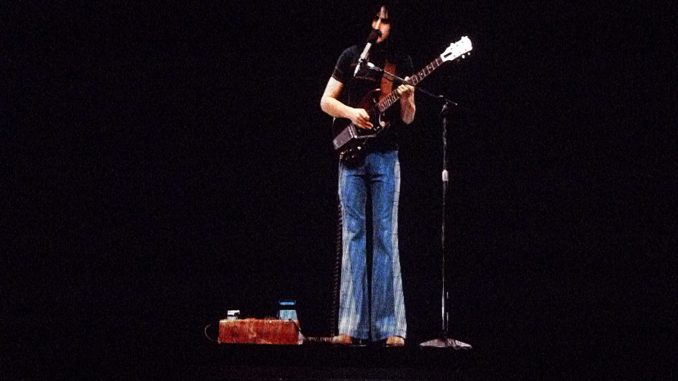
We can not know how Frank Zappa would stage a rock show today. Probably completely different. But he would have enjoyed the „The Bizarre World of Frank Zappa“. The audience in the Palladium London certainly celebrated the show – with Zappa as hologram and Ray White (guitar, vocals), Mike Keneally (guitar, keyboards, musical director), bassist Scott Thunes, Robert Martin (keyboards, sax, vocals), Percussionist Ed Mann and drummer / Zappa-Archivist Joe Travers. (much more pictures here)
By Dylan Cem Akalin
Well, as a „hologram“ I imagine something else. The show under the official label of the Zappa Family Trust is entertaining. No question. But is that also „Zappa“? The strange thing is that you do not even notice the band at first. Because they are left and right of the screens in the center, in the semi-darkness.
Of course, the focus is on Frank Zappa. No question! But do you have to be so in the background? Frank Zappa’s image flickers across the screen as a digital pixel artwork, sometimes as a shadowy virtuoso, often as a funny comic figure. But that’s how Frank greets us with a metallic echoing voice that sounds as though it came straight from the beyond: „You will not believe it, but I’m happy to see you guys as you are to see the show. I’m your resident buffoon and my name is Frank. „
The fool, then. Yes, as a jester like Eulenspiegel, who made the company a long nose, he always liked to present himself. And the audience enjoys the show in the beautiful theater on Oxford Circle. Incidentally, among the many guests, I also saw Progrock light figure Steven Wilson. In addition: Carl Palmer, Billy Bragg, Nick Beggs (The Mute Gods, Kajagoogoo) and the former XTC guitarist Dave Gregory. Probably more celebrities from the London Society were there.
„Cosmic Debris“ rattles and echoes
Probably every Zappa music lover would have made a different song selection, but she was fine. What is indeed a treat for fans: The guitar solos of the master, who died 25 years ago at the age of 53, come almost all from previously unpublished material. The „interaction“ between the off-FZ and the live band, which by the way is simply terrific, is accordingly exciting.
„Cosmic Debris“ rattles and sometimes sounds quite awful, but „Montana“, accompanied by animated dental floss, which meanders again and again into new characters, is great, especially the well-known wah-wah-distorted guitar solo.
„Trouble Every Day“
A highlight is the production of „Trouble Every Day“, written in the early 60s under the influence of the riot and civil rights movement under Martin Luther King, but the explosiveness and timeliness were unsurpassed in their lifetime and were always played by FC – in really many Variations and arrangements. One of the best versions is certainly the one on „Roxy & Elsewhere“. Here the multi-layered and wild music is accompanied by picture collages, newspaper clippings, documentations from several demonstrations from recent American history. So clearly political, the piece has probably never been presented by FZ itself – he has always denied any political appropriations (that’s why his music system was once demolished by the Berlin student movement in the end of the 60s!). By the way: fantastic sax solo by Robert Martin.
„Penguin in Bondage“, this crazy musical witch ride, is partly grotesquely animated – neon masks shine, noses crawl over white cocaine mountains, and Zappa herself sits relaxed on the sofa, the inevitable cigarette in her fingers, watching the penguin play the guitar – and later he watches as the penguin is flogged by a dominatrix.
Psychedelic colors and shapes bounce against us, while Scott Thunes plays such a powerful bass on „apostrophes“ that the walls shake.
„The Evil Prince“
„The Evil Prince“ from the 1984 album „Thing-Fish“ has something of a morality with its almost spoken, inharmonious vocals. Ray White’s vocals are accompanied by Bruce Bickford’s modeling clay animations from the TV show „A Token of His Extreme“ (1974). Not quite fitting, I think. The highlight is the guitar solo by Mike Keneally, a really great musician. And one who has very well adapted these solos by FZ beyond the usual pentatonics. Keneally may play a bit more accurate than FZ ever did.
Wonderful also „Zomby Woof“ – without the animated FZ.The second set starts with the completely unknown instrumental „# 2“ and leads to „Why Does It Hurt When I Pee?“ – with FC as a conductor in a white coat, as well as a beloved role on stage. After „Peaches en Regalia“, the band dives into the animated aquarium on „Stink-Foot“. We see Zappa as a muscle man on the beach, sometimes as a Castro blend that threatens America with the biological weapon „Stinkfoot“. Of course, even FC on the toilet must not be missing, but he sends us a cosmic solo from the otherworld, so that the fans get up enthusiastically. Somehow, everything is colorful here, all a bit Dada, but of course with a wink. And so it becomes clear again, what complete work of art Zappa has left behind.
A special moment is when the band plays an unprecedented piece of FZ, which was probably created in the 70s from parts of „Farther O’Blivion“, „Greggery Peccary“ and „Bebop Tango“. It typically begins with Zappaesk’s mix of reggae, ballads and avant-garde until all the musicians are somehow disconnected from all structures and finally reunited to provide the rhythmic rug for a fabulous guitar solo by Keneally, eventually featuring saxophone and a spacey xylophone is replaced. „The Dangerous Kitchen“ is launched with the beginning of „Inca Roads“, gently sung by Ray White. At „Dinah-Moe Humm“, FZ performs as a 70s greasy rag and dances with two barebacked women, „City of Tiny Lites“ is accompanied by nostalgic filming of the musicians. The concert ends with „Dirty Love“.
Ahmet und Diva
For the encore, Zappa’s son Ahmet and daughter Diva come on stage and perform „Dead Girls of London“. The crew surprised Ahmet with birthday cake, and then the band plays „Cheepnis“ (funny monster cartoons) and „Camarillo Brillo“.
Of course, the show is a must for old Zappa fans. One feels between laughing and crying, between nostalgic indulgence and irritated wondering. What speaks for the concept, is that it is presented with a wink, that the concept of continuity, what FZ himself pursued, is actually taken up – but with a lot of wit and imagination. Zappa himself asked on an album title „Does Humor Belong in Music?“. The answer is clear: yes!
